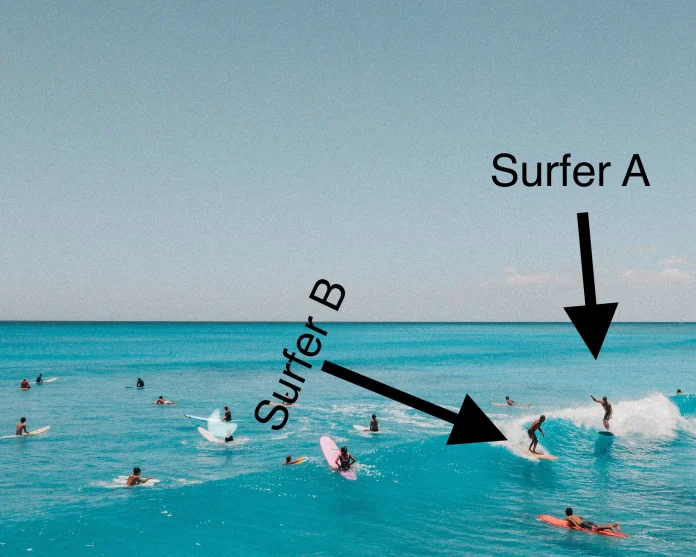Catch Waves, Not Trouble: Understand the Rules Before You Ride
Surf Etiquette: Understanding Priority and Staying Safe
Surfing is all about having fun, but it’s also about respecting the ocean and those who share it with you. When you’re out there on the waves, understanding surf etiquette ensures everyone gets the most out of their session—without conflict or accidents. Let’s break down a key situation: when Surfer A is by the peak of the wave and Surfer B is down the line. Who has priority? Let’s dive in!
1. Who Has Priority?
In the picture, Surfer A is positioned near the peak of the wave, while Surfer B is further down the line. The rule is simple: Surfer A, closer to the peak, has priority because they are the first to catch the wave. Surfer B should stay clear and let Surfer A take it. This is the most basic form of surf etiquette, but it’s crucial for avoiding collisions and ensuring smooth rides.
If Surfer B decides to take the wave anyway, they could potentially “drop in” on Surfer A, causing a dangerous situation. Always be aware of your position, and respect the rights of the surfer closest to the peak to maintain a safe and enjoyable session for all.
2. If You’re Nervous, Get Some Help
If you’re new to the ocean or not yet confident in your ability to handle waves, it’s important to take a surf lesson. Surfing isn’t just about catching waves—it’s about understanding the ocean, reading conditions, and knowing how to stay safe. If you’re unsure about your skills or the current, consider booking a lesson with an instructor who can help you get comfortable.
3. Always Have a Buddy
Surfing with a buddy is one of the best ways to stay safe, especially if you’re venturing into new or bigger surf. Having a friend with you ensures that if something goes wrong, help is close by. Even experienced surfers know the importance of having someone around—surfing solo, especially in unfamiliar waters, can be risky.
4. Respect the Ocean’s Power
The ocean is unpredictable, and even the most experienced surfers know it’s crucial to be aware of the waves, tides, and currents around them. If you’re nervous about being in the water, or if you’re unsure of how to paddle out safely, don’t hesitate to step back and take the time to learn. Remember, safety comes first—it’s better to take things slow and stay safe than to rush and risk injury.
5. Be Courteous to Other Surfers
Finally, even when you know who has priority and how to stay safe, always show respect for those around you. Surfing is about community. If you make a mistake—like misjudging a wave or taking off on a surfer’s line—acknowledge it with a quick wave or apology. This keeps the vibes positive and ensures that everyone enjoys their time in the water.
In Conclusion: Surf with Respect and Stay Safe
Whether you’re the one at the peak or down the line, knowing your priority and respecting other surfers is key to a fun session. And if you’re not feeling 100% confident, remember: take a lesson, surf with a buddy, and always prioritize safety. The ocean is there for everyone—let’s keep it fun, safe, and respectful.




